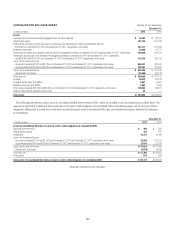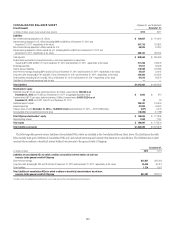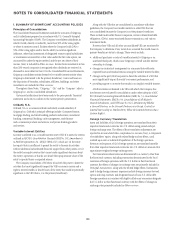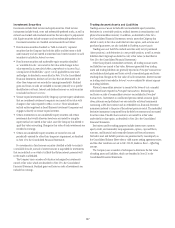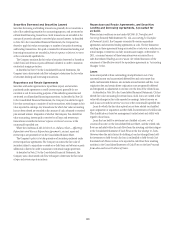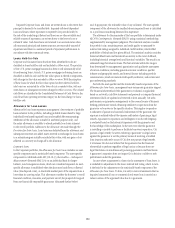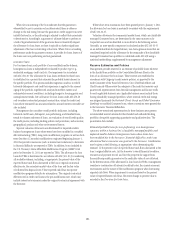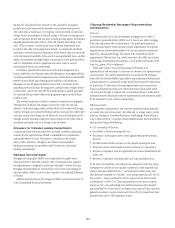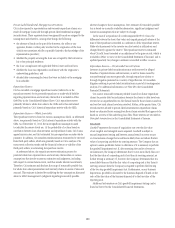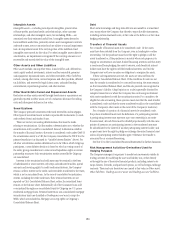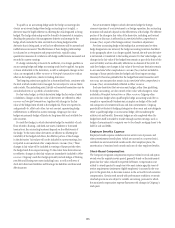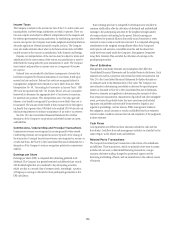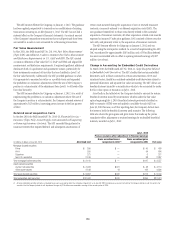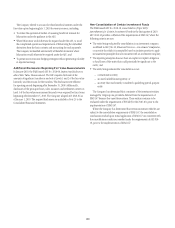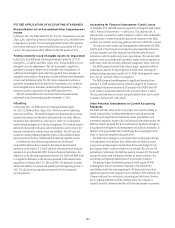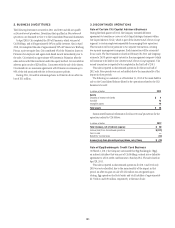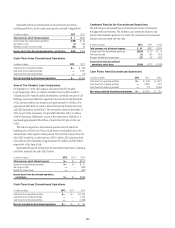Citibank 2012 Annual Report Download - page 174
Download and view the complete annual report
Please find page 174 of the 2012 Citibank annual report below. You can navigate through the pages in the report by either clicking on the pages listed below, or by using the keyword search tool below to find specific information within the annual report.152
Statistically calculated losses inherent in the classifiably managed
portfolio for performing and de minimis non-performing exposures.
The calculation is based upon: (i) Citigroup’s internal system of credit-risk
ratings, which are analogous to the risk ratings of the major rating agencies;
and (ii) historical default and loss data, including rating agency information
regarding default rates from 1983 to 2010 and internal data dating to the
early 1970s on severity of losses in the event of default. Adjustments may
be made to this data. Such adjustments include: (i) statistically calculated
estimates to cover the historical fluctuation of the default rates over the credit
cycle, the historical variability of loss severity among defaulted loans, and the
degree to which there are large obligor concentrations in the global portfolio;
and (ii) adjustments made for specific known items, such as current
environmental factors and credit trends.
In addition, representatives from each of the risk management and
finance staffs that cover business areas with delinquency-managed portfolios
containing smaller-balance homogeneous loans present their recommended
reserve balances based upon leading credit indicators, including loan
delinquencies and changes in portfolio size as well as economic trends,
including current and future housing prices, unemployment, length of time
in foreclosure, costs to sell and GDP. This methodology is applied separately
for each individual product within each geographic region in which these
portfolios exist.
This evaluation process is subject to numerous estimates and judgments.
The frequency of default, risk ratings, loss recovery rates, the size and
diversity of individual large credits, and the ability of borrowers with foreign
currency obligations to obtain the foreign currency necessary for orderly debt
servicing, among other things, are all taken into account during this review.
Changes in these estimates could have a direct impact on the credit costs in
any period and could result in a change in the allowance.
Allowance for Unfunded Lending Commitments
A similar approach to the allowance for loan losses is used for calculating
a reserve for the expected losses related to unfunded loan commitments
and standby letters of credit. This reserve is classified on the balance
sheet in Other liabilities. Changes to the allowance for unfunded
lending commitments are recorded in the Provision for unfunded
lending commitments.
Mortgage Servicing Rights
Mortgage servicing rights (MSRs) are recognized as intangible assets
when purchased or when the Company sells or securitizes loans acquired
through purchase or origination and retains the right to service the loans.
Mortgage servicing rights are accounted for at fair value, with changes in
value recorded in Other revenue in the Company’s Consolidated Statement
of Income.
Additional information on the Company’s MSRs can be found in Note 22
to the Consolidated Financial Statements.
Citigroup Residential Mortgages—Representations
and Warranties
Overview
In connection with Citi’s sales of residential mortgage loans to the U.S.
government-sponsored entities (GSEs) and, in most cases, other mortgage
loan sales and private-label securitizations, Citi makes representations
and warranties that the loans sold meet certain requirements. The specific
representations and warranties made by Citi in any particular transaction
depend on, among other things, the nature of the transaction and the
requirements of the investor (e.g., whole loan sale to the GSEs versus loans
sold through securitization transactions), as well as the credit quality of the
loan (e.g., prime, Alt-A or subprime).
These sales expose Citi to potential claims for breaches of its
representations and warranties. In the event of a breach of its representations
and warranties, Citi could be required either to repurchase the mortgage
loans with the identified defects (generally at unpaid principal balance plus
accrued interest) or to indemnify (make-whole) the investors for their losses
on these loans. To the extent Citi made representation and warranties on
loans it purchased from third-party sellers that remain financially viable,
Citi may have the right to seek recovery of repurchase losses or make-whole
payments from the third party based on representations and warranties made
by the third party to Citi (a back-to-back claim).
Whole Loan Sales
Citi is exposed to representation and warranty repurchase claims primarily
as a result of its whole loan sales to the GSEs and, to a lesser extent, private
investors, through its Consumer business in CitiMortgage. When selling a
loan to these investors, Citi makes various representations and warranties to,
among other things, the following:
• Citi’s ownership of the loan;
• the validity of the lien securing the loan;
• the absence of delinquent taxes or liens against the property securing
the loan;
• the effectiveness of title insurance on the property securing the loan;
• the process used in selecting the loans for inclusion in a transaction;
• the loan’s compliance with any applicable loan criteria established by the
buyer; and
• the loan’s compliance with applicable local, state and federal laws.
In the case of a repurchase, Citi will bear any subsequent credit loss on the
mortgage loan and the loan is typically considered a credit-impaired loan
and accounted for under SOP 03-3, “Accounting for Certain Loans and
Debt Securities Acquired in a Transfer” (now incorporated into ASC 310-30,
Receivables—Loans and Debt Securities Acquired with Deteriorated
Credit Quality) (SOP 03-3). These repurchases have not had a material
impact on Citi’s non-performing loan statistics because credit-impaired
purchased SOP 03-3 loans are not included in non-accrual loans, since they
generally continue to accrue interest until write-off. Citi’s repurchases have
primarily been due to GSE repurchase claims.


